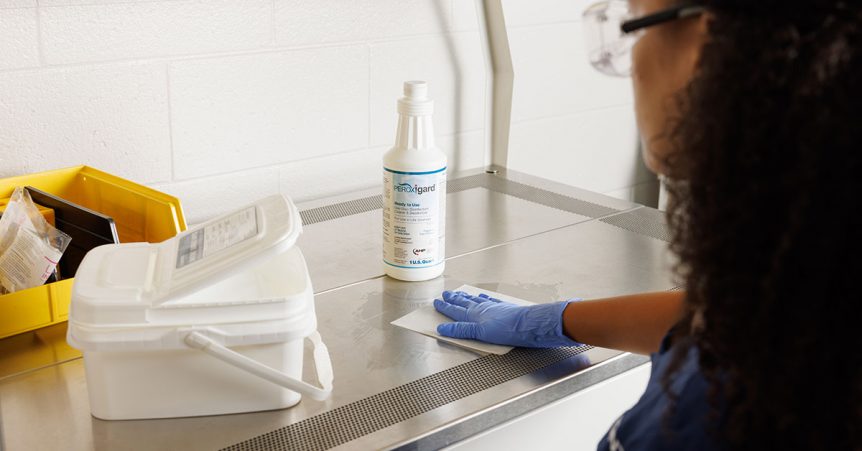At the annual AALAS Demo Day, we had the chance to present a guide for disinfectant selection for better biosecurity in life sciences facilities, which remains top of mind for research professionals due to the ever-present threat of pathogen contamination. However, disinfectant selection doesn’t need to be complicated – keeping a few key criteria in mind can help ensure that the disinfectant you choose is keeping your research safe.
Tough on Pathogens
Many life sciences facilities have bioexclusion lists, and need to ensure that their colonies are free from contamination by a range of bacteria, viruses and even fungi. While it is not practical for disinfectants to be tested against every potential pathogen, it is important to select a product with a broad spectrum of efficacy for confidence that it will kill organisms of concern. The disinfectant should carry efficacy label claims against bacteria, fungi and viruses, including hard-to-kill non-enveloped viruses such as Poliovirus and Parvovirus.
Gentle on Animals, People and Your Facility
Formulating a disinfectant that can kill pathogens is relatively easy – after all, people have been using harsh chemicals to disinfect surfaces for many years. The challenge is to be able to disinfect without harming the user, animals in the area, or the surface itself. Many commonly-used disinfectants based on legacy active ingredients, including chlorine dioxide or quaternary ammonium compounds, pose unacceptable health hazards to animals and users. Other disinfectants, such as Peroxigard™, strike the balance of being highly effective against pathogens while remaining non-toxic, non-irritating to eyes and non-corrosive to skin when used as directed. Furthermore, Peroxigard has been validated for compatibility with a wide range of commonly-used materials, preventing wear and tear on expensive laboratory equipment.
Compliance Made Easy
Even the most effective disinfectant on paper will not protect your facility if it doesn’t work well in real world conditions – as such, the ideal disinfectant also needs to be practical for use in laboratory environments.
One key aspect to consider when evaluating a disinfectant is the required contact time, which is the length of time that the solution must remain wet on the surface to be fully effective. Choosing a product with a rapid contact time is critical, to ensure that the solution does not evaporate before killing pathogens on the surface. Disinfectants with unrealistically long contact times may need to be reapplied multiple times for confidence that they are working properly. Peroxigard kills pathogens rapidly, with contact times ranging from one to five minutes.
In a perfect world, we would only ever need to disinfect surfaces that are completely clean, but we know that this is not always the case in real-world settings. Even surfaces that look visibly clean may be contaminated with low levels of soils, and may be harboring harmful pathogens. Disinfection cannot work without cleaning, which is the process of physically removing dirt and debris so that remaining pathogens can be properly targeted by the disinfectant. If using a disinfectant that does not have detergency properties, surfaces should be pre-cleaned with detergent prior to disinfection to dislodge residual soils. However, using a one-step disinfectant cleaner such as Peroxigard, that is formulated with surfactants, can streamline protocols by eliminating the need for multiple products.
When searching for a disinfectant that is easy to use, another factor to consider is the formats that are available and ensure that the offerings will meet your facility’s needs. For example, if you need to disinfect large areas, a dilutable concentrate may offer the most economical solution. For high-touch surfaces, ready-to-use wipes and liquids provide a convenient option for quick and easy disinfection. Ideally, the disinfectant will not require activation or mixing of multiple different chemicals, as complicated preparation increases the risk of user error. Peroxigard is available in both a concentrate as well as ready-to-use wipes and spray products, to suit a diversity of applications.
Choosing the right disinfectant for life sciences facilities comes down to a balance between efficacy, safety and simplicity. Peroxigard Disinfectants offer an effective, safe and practical solution to protect animals, research and people from the threat of infection.



